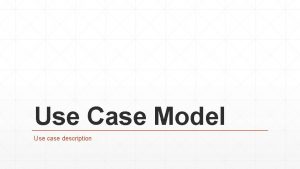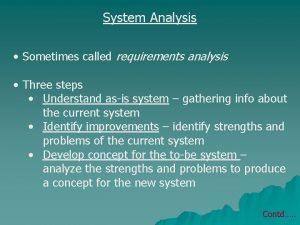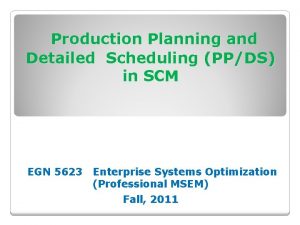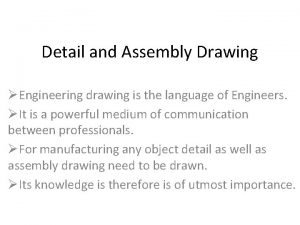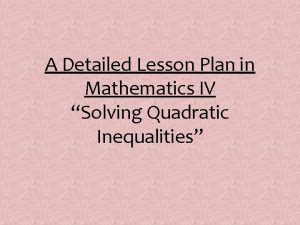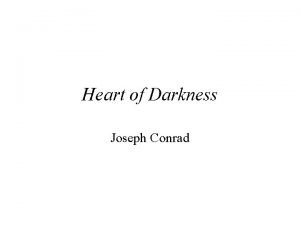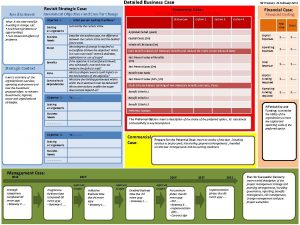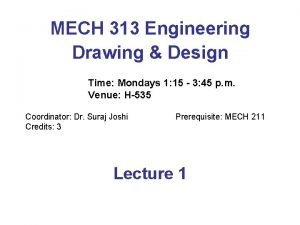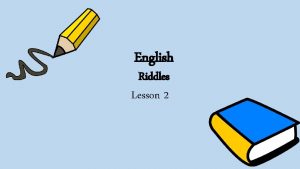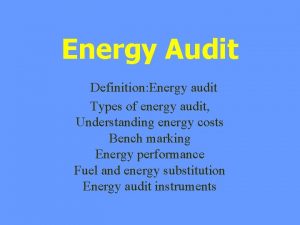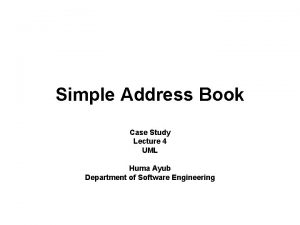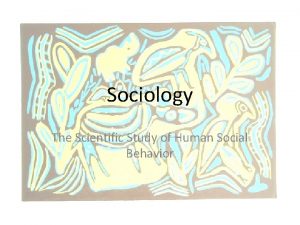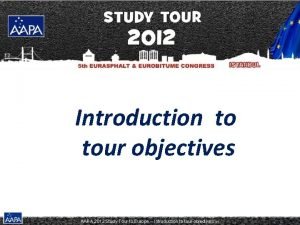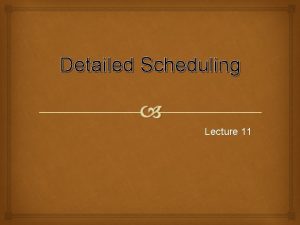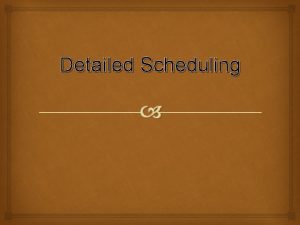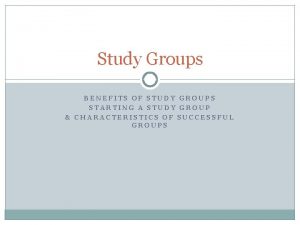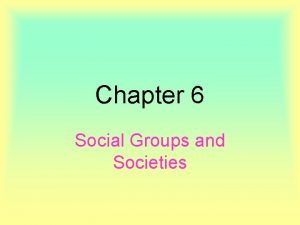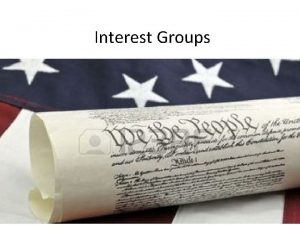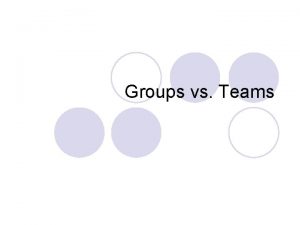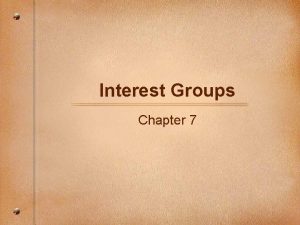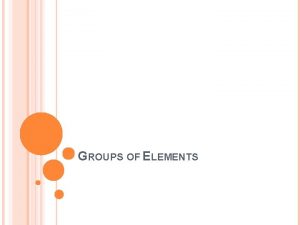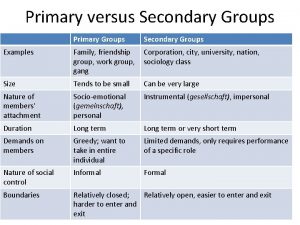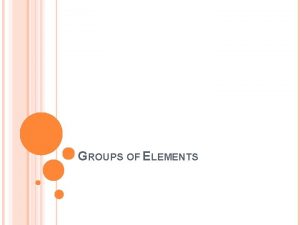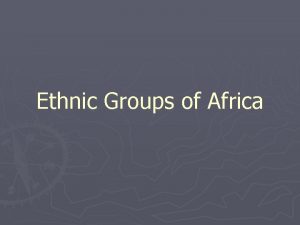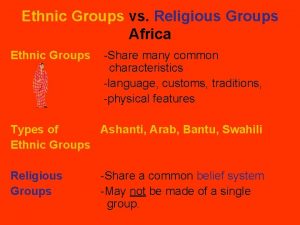GROUPS 1 1 Introduction Detailed Study of groups




















![b 1=(b 1. a). b 2 [by associativity] =e. b 2 = b 2 b 1=(b 1. a). b 2 [by associativity] =e. b 2 = b 2](https://slidetodoc.com/presentation_image_h/dff49651d6707097ee6ad6668e2f925d/image-21.jpg)




























- Slides: 49

GROUPS 1

1. Introduction Detailed Study of groups is a fundamental concept in the study of abstract algebra. To define the notion of groups, we require the concept of binary operation or composition which is a type of function that associates two elements of the set to a unique element of that set. 2

Definition Of Binary Operation A binary operation on a set is a rule for combining two elements of the set. More precisely, if S iz a nonempty set, a binary operation on S iz a mapping f : S S S. Thus f associates with each ordered pair (x, y) of element of S an element f(x, y) of S. IN OTHER WORDS, An operation which combine two elements of a set to give another elements of the same set is called a binary operation 3

Example Of Binary Operation 1. Ordinary addition ‘+’ is a binary operation on Z Consider +: (Z*Z) Z +: (3, 7)=3+7=10 ∈Z 4

Definition Of Algebraic Structure A non-empty set G equipped with one or more binary operation defined on it is called an algebraic structure. Suppose ‘*’ is a binary operation on G , then (G , *) is an algebraic structure. 5

Definition of Groups A group (G, ・) is a set G together with a binary operation ・ satisfying the following axioms. (i) Closure property: a. b ∈ G for all a, b ∈ G. (ii) The operation ・ is associative; that is, (a ・ b) ・ c = a ・ (b ・ c) for all a, b, c ∈ G. (iii) There is an identity element e ∈ G such that e ・ a = a ・ e = a for all a ∈ G. (iv) Each element a ∈ G has an inverse element a− 1 ∈ G such that -1 a・ a = a ・ a− 1 = e. 6

Abelian Group A group (G , . ) is said to be abelian or commutative if in addition to the above four postulates, the following postulate is also satisfied: COMMUTATIVE PROPERTY: If the operation is commutative, that is, if a ・ b = b ・ a for all a, b ∈ G, the group is called commutative or abelian group 7

Example Of Group Example: Let G be the set of complex numbers {1, − 1, i, −i} and let ・ be the standard multiplication of complex numbers. Then (G, ・) is an abelian group. The product of any two of these elements is an element of G; thus G is closed under the operation. Multiplication is associative and commutative in G because multiplication of complex numbers is always associative and commutative. 8

Example Of Group (CONTD. ) The identity element is 1, and The inverse of each element a is the element 1/a. Hence 1− 1 = 1 , (− 1)− 1 = − 1 , i− 1 = −I , and (−i)− 1 = i. 9

EXAMPLE (2) Show that Z(the set of all integers) is an abelian group w. r. t. addition Solution. (i) CLOSURE PROPERTY: since the sum of two integers is also an integer i. e. , a+b ∈ Z for all a, b ∈ Z Therefore the set Z is closed w. r. t. addition. Hence closure property is satisfied. (ii) ASSOCIATIVE LAW: since addition of integers obey associative law, therefore a+(b+c)=(a+b)+c for all a, b, c ∈ Z 10

Thus addition is an associative composition. (iii) EXISTENCE OF IDENTITY: the number 0 ∈ Z and a+0 = 0+a =a for all a ∈ Z The integer 0 is the identity for (Z , +) (iv) EXISTENCE OF INVERSE: for each a ∈ Z, There exists a unique element -a ∈ Z such that a+(-a)=0=(-a)+a Thus each integer possesses an additive inverse. 11

(v) COMMUTATIVE LAW: the commutative law holds good for addition of integers i. e. a+b=b+a for all a, b ∈ Z Thus (Z , +) is an abelian group. Also Z contains an infinite number of elements. therefore (Z , +) is an abelian group of infinite order. 12

Definition Of Semi-Group An algebraic structure (G , *) is called a semigroup, if only the first two postulates, i. e. , closure and associative law are satisfied. 13

Example Of Semi-Group The algebraic structure (N , +), (W , +), (Z, +), (R, +) and (C, +) are semi-groups, where N , W , Z , R and C have usual meanings. 14

Definition Of Finite And Infinite Groups Definition: If the number of elements in the group G are finite, then the group is called a finite group otherwise it is an infinite group 15

Example Of Finite And Infinite Group Example of Finite Group: {1, − 1, i, −i} is an example of finite group. Example of Infinite Group: (Z , +) is an example of infinite group. 16

Order Of A Group Definition: The number of elements in a finite group is called the order of the group. An infinite group is said to be of infinite order. The order of a group G is denoted by the symbol o(G). 17

General properties of groups If (G , . ) is a group, then (i) the identity element of G is unique. (ii) every element has a unique inverse. 18

The Identity Element Of G Is Unique Proof: : If possible let e 1 and e 2 be two identities in the group (G, . ) Since e 1 is identity and e 2 ∈ G therefore e 1. e 2 = e 2. e 1 …. . (1) Also since e 2 is the identity and e 1 ∈ G therefore e 1. e 2 = e 1 = e 2. e 1 …. . (2) therefore from (1) and (2), e 1 = e 2 Hence the identity is unique 19

Every element has unique inverse PROOF: Let a be any element of the group ( G , . ) If possible , let b 1 and b 2 be two inverses of a under the binary operation ‘. ‘ and let e be the identity element in G. Then a. b 1 = e = b 1. a And a. b 2 = e = b 2. a Now b 1 = b 1. e =b 1. ( a. b 2) 20
![b 1b 1 a b 2 by associativity e b 2 b 2 b 1=(b 1. a). b 2 [by associativity] =e. b 2 = b 2](https://slidetodoc.com/presentation_image_h/dff49651d6707097ee6ad6668e2f925d/image-21.jpg)
b 1=(b 1. a). b 2 [by associativity] =e. b 2 = b 2 Therefore b 1 = b 2. hence the inverse is unique. 21

Proposition. If a, b are elements of a group G , then (i) (a− 1)− 1 = a. (ii) (ab)− 1 = b− 1 a− 1. i. e. , the inverse of the product of two elements of a group is the product of their inverses in the reverse order. 22

Proof of (a− 1)− 1 = a Proof: for each a ∈ G, we have a. a− 1 = e = a− 1. a Þ Inverse of a− 1 is a. Therefore (a− 1)− 1 = a 23

Proof of Proof: 24

SUBGROUPS 25

Definition of Subgroups: : It often happens that some subset of a group will also form a group under the same operation. Such a group is called a subgroup. If (G, ・) is a group and H is a nonempty subset of G, then (H, ・) is called a subgroup of (G, ・) if the following conditions hold: (i) a ・ b ∈ H for all a, b ∈closure) H. ( (ii) a− 1 ∈ H for all a ∈ existence H. ( of inverses) Conditions (i) and (ii) are equivalent to the single condition: (iii) a ・ b− 1 ∈ H for all a, b ∈ H. 26

THEOREM: Prove that: (i) The identity of the sub-group is same as that of the group. (ii) The inverse of any element of a sub-group is the same as the inverse of that element in the group. 27

Proof : let H be a sub-group of the group G. if e is the identity element of G, then ea = ae = a for all a ∈ G (i) As H is a sub-set of G therefore ea = ae= a for all a ∈ H ∈ G] [ since ∈ H => a a => e is an identity element of H. Hence identity of the sub-group is same as that of the group. 28

Proof: (ii) Let e be the identity of G as well as of H. Let a be any element of H Þ a is an element of group G suppose b is the inverse of a in H and c is the inverse of a in G. Þ ab = ba = e …. . (1) ac = ca = e …. (2) From (1) & (2), ab = ac Therefore b=c Hence, the result. 29

Example of subgroup: LET G be the additive group of integers. Prove that the set of all multiples of integers by a fixed integer k ig a subgroup of G. Solution. Let G = {…. , -4 , -3 , -2 , -1 , 0 , 1 , 2 , 3 , 4 , …. . } i. e. G is additive group of integers. Let H = {… , -3 k , -2 k , -k , 0 , k , 2 k , 3 k , …. } Therefore H ≠ ф Here H is a subset of G. We have to show that H is a subgroup of G. 30

Let ak , bk be any two elements of H such that a , b are integers. Inverse of bk in G is –bk. Now ak - bk = (a - b)k , which is an element of H as (a – b) is some integer. Thus for ak , bk ∈ H , we have ak – bk ∈ H Hence H is a subgroup of G. 31

Example: Let H be the multiplicative group of all positive real numbers and R the additive group of all real numbers. Is H a subgroup of R ? Solution : H is a subset of R but H is not a subgroup of R , The reason being that the composition in H is different from the composition in R. 32

Order of an element Definition. Let G be a group and let a G ane e be the identity element in G. If ak = e for some k 1, then the smallest such exponent k 1 is called the order of a; if no such power exists, then one says that a has infinite order. 33

CYCLIC GROUP AND COSETS 34

CYCLIC GROUPS If G is a group and a G, write <a > = {an : n Z} = {all powers of a }. It is easy to see that <a > is a subgroup of G. < a > is called the cyclic subgroup of G generated by a. A group G is called cyclic if there is some a G with G = < a >; in this case a is called a generator of G. Definition. 35

THEOREM: If a finite group of order ‘s’ contains an element of order ‘s’ , then the group must be cyclic. Proof: Let G be a finite group and o(G)= s Let a G such that o(a)= s If H = {an : n Z} Then o(H) = s = o(a) Therefore H is a cyclic subgroup of G. Also o(H) = o(G) implies G itself is a cyclic group and a is a generator of G. 36

EXAMPLE of cyclic group. Example: If G = {0 , 1 , 2 , 3 , 4 , 5 } and binary operation + 6 is Then prove that G is a cyclic group. Solution. we see that 1 1=1 12 = 1+ 6 1 = 2 3 2 1=1 +61=3 4 3 1 = 1 +6 1 = 4 37

5 4 1=1 +6 1=5 5 6 1 =1 +6 1=0 Therefore G = { 0 , 1 , 2 , 3 , 4 , 5 } is a cyclic group. 1 is generator of given group. Therefore G=<1> Hence proved 38

COSETS: Definition: let G be a group and H be any subgroup of G. For any a G , the set Ha = { ha : h H} is called right coset of H in G generated by a. Similarly, the set a. H = { ah : h H} is called left coset of H in G generated by a. Obviously , Ha and a. H are both subsets of G. H is itself a right and left coset as e. H =He , where e is an identity of G. 39

Example of cosets: Find the right cosets of the subgroup { 1, -1 } of the group { 1 , -1 , i, -i} w. r. t. usual multiplication. Solution. let G = { 1 , -1 , i, -i} be a group w. r. t. usual multiplication And H = { 1, -1 } be a subgroup of G. The right cosets of H in G are H(1) = {1(1) , -1(1)} = {1 , -1}= H 40

H(-1)={1(-1) , -1(-1)}={-1 , 1}=H H(i)={1(i) , -1 (i)} ={i, -i} H(-i) = {1(-i) , -1(-i)}= {-i , i} thus we have only two distinct right cosets of H in G. 41

ASSIGNMENT Define group. Show that Z (the set of all integers) is an abelian group w. r. t. addition. 2. Show that the set of integers Z is an abelian grop w. r. t. binary operation ‘ * ‘ defined as a * b = a + b + 1 for a , b ∈Z. 3. If (G , . ) is a group, then (i) the identity element of G is unique. 1. (ii) every element has a unique inverse. 42

ASSIGNMENT 4. If a, b are elements of a group G , then (i) (a− 1)− 1 = a. (ii) (ab)− 1 = b− 1 a− 1. i. e. , the inverse of the product of two elements of a group is the product of their inverses in the reverse order. 5. If every element of a group is its own inverse, then show that the group is abelian. 6. If a group has four elements , show that it must be abelian 43

ASSIGNMENT 7. The order of every element of a finite group is finite and is less than or equal to the order of the group. 8. Let G = { 0 , 1 , 2 , 3 , 4 , 5 }. Find the order of elements of the group G under the binary operation addition modulo 6. 9. Define subgroup. Let G be the additive group of integers. Prove that the set of all multiples of integers by a fixed integer k ig a subgroup of G. 44

ASSIGNMENT 10. Prove that: (i) the identity of the subgroup is same as that of the group. (ii) the inverse of any element of a subgroup is the same as the inverse of that element in the group. 11. Let H be the multiplicative group of all positive real numbers and R the additive group of all real numbers. Is H a subgroup of R? 45

ASSIGNMENT 12. Let G be a group with binary operation denoted as multiplication. The set {h ∈ G : for all x }∈is. Gcalled the centre of the group G. Show that the centre of G is a subgroup of G. 13. Define cyclic group. If a finite group ‘ s ‘ contains an element of order ‘ s ‘ , then the group must be cyclic. 46

ASSIGNMENT 14. If G = { 0 , 1 , 2 , 3 , 4 , 5 } and binary operation is addition modulo 6 , then prove that G is a cyclic group. 15. Define cosets. Find the right cosets of the subgroup { 1 , -1 } of the group { 1, -1 , i , -i} w. r. t. usual multiplication. 47

TEST DO ANY THREE QUESTIONS. 1. If a, b are elements of a group G , then (i) (a− 1)− 1 = a. (ii) (ab)− 1 = b− 1 a− 1. i. e. , the inverse of the product of two elements of a group is the product of their inverses in the reverse order. 2. Define cyclic group. If a finite group ‘ s ‘ contains an element of order ‘ s ‘ , then the group must be cyclic. 48

TEST 3. If G = { 0 , 1 , 2 , 3 , 4 , 5 } and binary operation is addition modulo 6 , then prove that G is a cyclic group. 4. Define cosets. Find the right cosets of the subgroup { 1 , -1 } of the group { 1, -1 , i , -i} w. r. t. usual multiplication. 5. Define subgroup. Let G be the additive group of integers. Prove that the set of all multiples of integers by a fixed integer k ig a subgroup of G. 49
 How are ethnic groups and religious groups related
How are ethnic groups and religious groups related Brief use case description example
Brief use case description example Bpa bpi bpr
Bpa bpi bpr Reading for detail
Reading for detail Ppds heuristics
Ppds heuristics Hairdressing lesson plans
Hairdressing lesson plans The main objectives of a detailed system proposal are to
The main objectives of a detailed system proposal are to First death in nova scotia poetic techniques
First death in nova scotia poetic techniques Antenna effect in vlsi
Antenna effect in vlsi Cocomo estimation
Cocomo estimation Dovetail joint drawing
Dovetail joint drawing Detailed lesson plan about quadratic equation
Detailed lesson plan about quadratic equation Detailed design in software engineering
Detailed design in software engineering Preload fork
Preload fork Plot summary of heart of darkness by joseph conrad
Plot summary of heart of darkness by joseph conrad Function oriented design
Function oriented design Detailed business case
Detailed business case Intermediate cocomo example
Intermediate cocomo example Write a detailed note on unicast routing protocols
Write a detailed note on unicast routing protocols Detail drawing example
Detail drawing example In engineering
In engineering Map southern spain
Map southern spain Horizontal drawing
Horizontal drawing Detailed lesson plan about riddles
Detailed lesson plan about riddles First cut design class diagram
First cut design class diagram Detailed comprehension
Detailed comprehension Detailed energy audit methodology
Detailed energy audit methodology Local area decision network
Local area decision network Practical experience requirements cima
Practical experience requirements cima Detailed address
Detailed address Sector sketch vs range card
Sector sketch vs range card Detailed lesson plan about coral reefs
Detailed lesson plan about coral reefs Distributed shared memory
Distributed shared memory India baby tossing
India baby tossing Itu t study groups
Itu t study groups Ecological study vs cohort study
Ecological study vs cohort study Retrospective cohort study
Retrospective cohort study Process of method study
Process of method study Study less study smart
Study less study smart Phytogeographical region of india
Phytogeographical region of india Time study objectives
Time study objectives Time and motion study example ppt
Time and motion study example ppt What is field study 1 in education
What is field study 1 in education Chapter 1 the study of life
Chapter 1 the study of life Study tour introduction
Study tour introduction Introduction paragraph structure
Introduction paragraph structure Modern english lexicology
Modern english lexicology Mbti team building workshops
Mbti team building workshops Vir das mbti
Vir das mbti Auxocromo
Auxocromo

